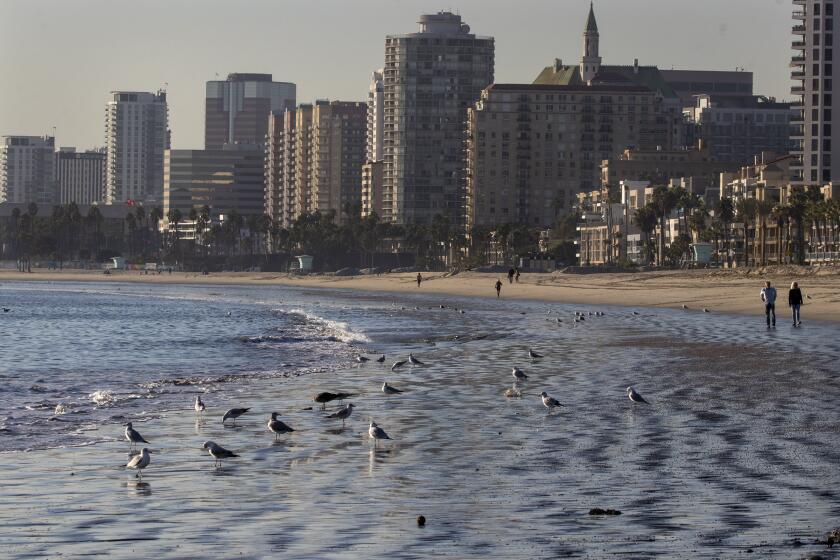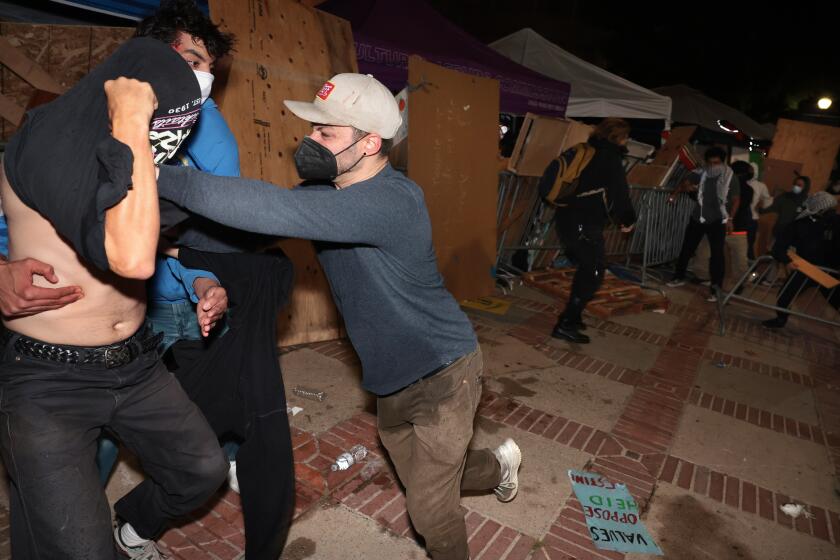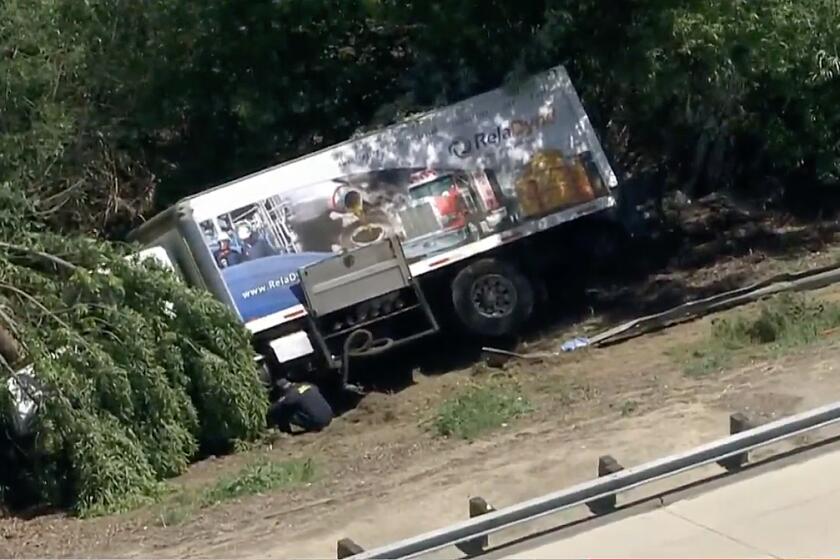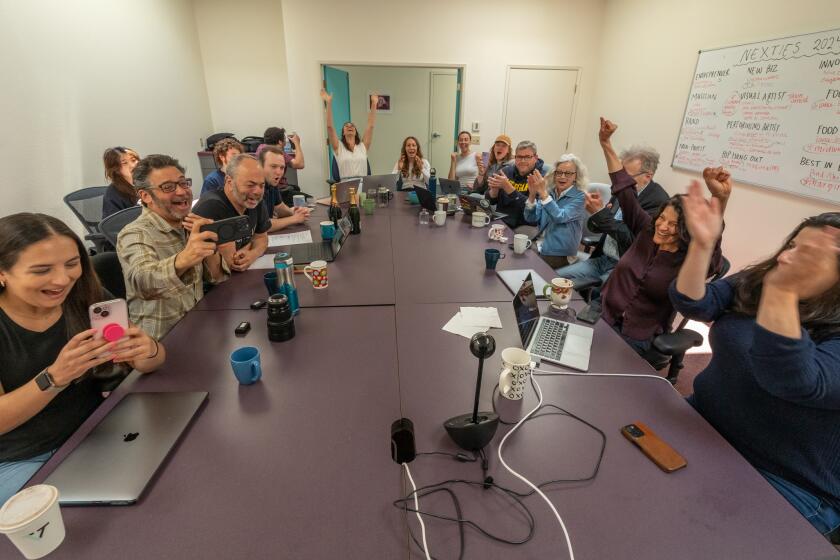A park, a school — and a lot of wasted money
Residents who live around 45th Street and Central Avenue cheered when they learned the city of Los Angeles was working to transform a vacant lot across from a public library into a small park for children in the neighborhood.
The city spent more than $600,000 designing and building Vernon Branch Library Pocket Park in South Los Angeles, according to documents reviewed by The Times. But no one got to use it.
Instead of a grand opening, workers put a fence around it. Then, after two years, it was bulldozed. Now it’s a construction site, to eventually be part of a new campus being built by the Los Angeles Unified School District.
Some residents are still shaking their heads over the wasted money.
“That’s crazy,” said Ricky Johnson, 52, who grew up in the neighborhood.
The razing of the park is an extreme illustration of the disconnect that at times exists between the school district and the city over land use.
It also serves as a cautionary tale for Mayor Antonio Villaraigosa, who recently launched a campaign to build 50 pocket parks across the city.
Acquiring land for parks has proved difficult, particularly in built-out urban areas like South L.A. where the need for open space is the greatest. There’s great demand from both public and private entities for prime open land. And some of what’s still available is contaminated by previous industrial users and could require expensive cleanup.
In the case of the Vernon Library Pocket Park, the land wasn’t contaminated — which made it attractive to both the school district and the city. Each hatched plans at the same time, holding numerous community meetings about their visions and generating public documents that clearly spelled out their intentions.
Neither entity knew what the other was doing.
That lack of communication resulted in a costly collision course.
“Sad,” said Robert Garcia, executive director of the City Project, which advocates for more parks in low-income neighborhoods. “This shows that government doesn’t work in L.A. … in a rational world, people would coordinate.”
Brianna Garcia, a facilities development manager for L.A. Unified, said officials began looking at the plot in March of 2007 as among a few potential sites for Central Region Elementary School 21, a campus district officials said the community badly needed because of severe overcrowding in the area.
At that time, she said, data from the county assessor’s office showed that the parcel was vacant and owned by the Department of Water and Power.
In a letter to the DWP, the district said it was considering the land for a school site.
DWP officials did not reply, Garcia said. That’s could be because the DWP was no longer connected to the land, having given it to the city parks department in 2003. School officials said the transfer didn’t show up in county records, perhaps because it was an interdepartmental transfer that did not include a formal escrow.
District officials said they do exhaustive research into potential school sites, including mapping gang territory, identifying liquor stores and noting the time and location of things like Alcoholics Anonymous meetings.
In 2008 — right around the time workers were finishing the landscaping — school district officials decided on the Central Avenue site as their preferred location. They still had no idea a park was there.
“We definitely would have taken it into consideration,” Garcia said. “Instead of thinking, ‘Oh, there’s a vacant piece of land owned by the DWP,’ we would have said, ‘Oh, there’s a pocket park.’”
While L.A. Unified was doing its planning, so was the city. After securing state bond money in 2006, it spent two years holding its own community meetings and designing and building the park.
Right about the time city officials began scheduling community leaders and elected officials to attend the grand opening ceremony, they got word from the district that it was planning to seize the land through eminent domain.
District officials eventually learned the land had been turned into a park but decided it still made sense to build a school there, Garcia said.
Recent fights over land use have featured a lawsuit and the spectacle of city and school officials publicly sniping at each other. But in this case, officials on both sides describe their interactions over the pocket park as amicable.
In the end, the city decided not to fight the district. In exchange, the district agreed to build a replacement park nearby — fully paid for with district funds — that will be opened when the school is finished.
“Both of us are happy with the outcome,” Garcia said.
Others said the park saga came with a price.
Said Neil Drucker, program manager for the city’s recreation and cultural facilities program: “The city spent a lot of time, effort and money on this. There will be a replacement park, but it’s not without cost … all our staff time, the design, the meetings, the projects that could have been done instead.”
Many park activists and residents say they are flabbergasted.
Garcia, of the City Project advocacy group, said it makes no sense that the city and the school district don’t work better together. He said officials should find a way to open all school fields and pools — not just a few — for use as parks during off hours, especially in neighborhoods as park-poor as South Los Angeles.
Guadalupe Cardenas, who lived near the bulldozed park, said she and her two sons had excitedly watched its progress.
“But it just came and went,” she said.
More to Read
Start your day right
Sign up for Essential California for news, features and recommendations from the L.A. Times and beyond in your inbox six days a week.
You may occasionally receive promotional content from the Los Angeles Times.






